国际经济学第十版课后答案 (萨尔瓦多、杨冰译)
国际经济学第十版答案
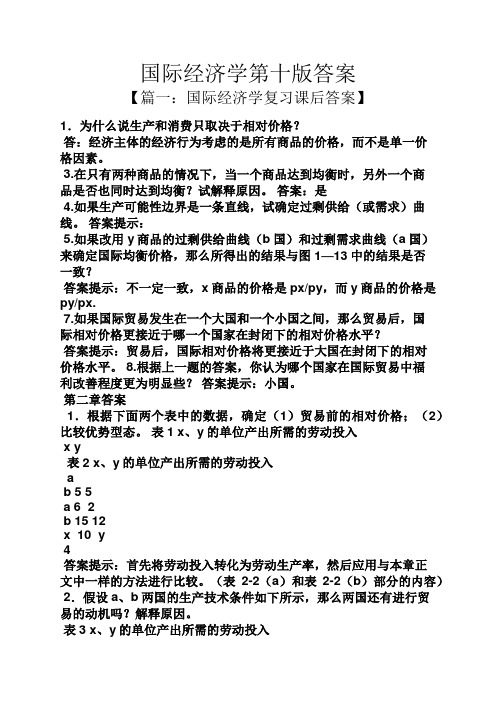
国际经济学第十版答案【篇一:国际经济学复习课后答案】1.为什么说生产和消费只取决于相对价格?答:经济主体的经济行为考虑的是所有商品的价格,而不是单一价格因素。
3.在只有两种商品的情况下,当一个商品达到均衡时,另外一个商品是否也同时达到均衡?试解释原因。
答案:是4.如果生产可能性边界是一条直线,试确定过剩供给(或需求)曲线。
答案提示:5.如果改用y商品的过剩供给曲线(b国)和过剩需求曲线(a国)来确定国际均衡价格,那么所得出的结果与图1—13中的结果是否一致?答案提示:不一定一致,x商品的价格是px/py,而y商品的价格是py/px.7.如果国际贸易发生在一个大国和一个小国之间,那么贸易后,国际相对价格更接近于哪一个国家在封闭下的相对价格水平?答案提示:贸易后,国际相对价格将更接近于大国在封闭下的相对价格水平。
8.根据上一题的答案,你认为哪个国家在国际贸易中福利改善程度更为明显些?答案提示:小国。
第二章答案1.根据下面两个表中的数据,确定(1)贸易前的相对价格;(2)比较优势型态。
表1 x、y的单位产出所需的劳动投入x y表2 x、y的单位产出所需的劳动投入ab 5 5a 6 2b 15 12x 10 y4答案提示:首先将劳动投入转化为劳动生产率,然后应用与本章正文中一样的方法进行比较。
(表2-2(a)和表2-2(b)部分的内容) 2.假设a、b两国的生产技术条件如下所示,那么两国还有进行贸易的动机吗?解释原因。
表3 x、y的单位产出所需的劳动投入x ya 4 2b 8 4答案提示:从绝对优势来看,两国当中a国在两种产品中都有绝对优势;从比较优势来看,两国不存在相对技术差异。
所以,两国没有进行国际贸易的动机。
3.如果一国在某一商品上具有绝对优势,那么也必具有比较优势吗?答案提示:不一定,比较优势的确定原则是两优取最优,两劣取最劣。
5.假设某一国家拥有20,000万单位的劳动,x、y的单位产出所要求的劳动投入分别为5个单位和4个单位,试确定生产可能性边界方程。
国际经济学的课后答案及选择
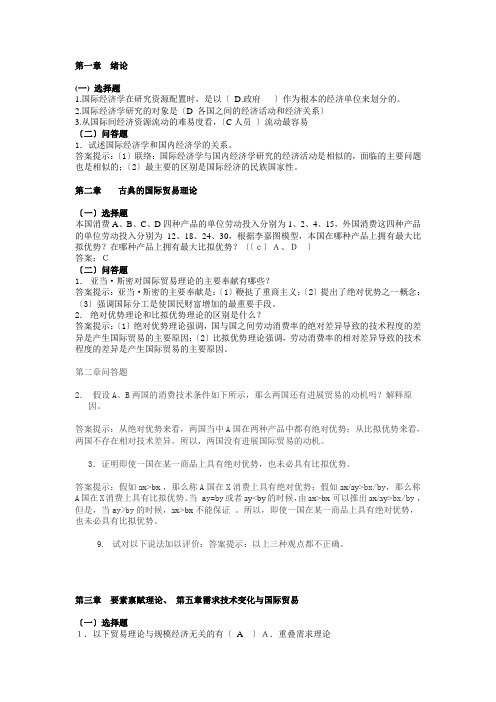
第一章绪论(一) 选择题1.国际经济学在研究资源配置时,是以〔D.政府〕作为根本的经济单位来划分的。
2.国际经济学研究的对象是〔D 各国之间的经济活动和经济关系〕3.从国际间经济资源流动的难易度看,〔C人员〕流动最容易〔二〕问答题1.试述国际经济学和国内经济学的关系。
答案提示:〔1〕联络:国际经济学与国内经济学研究的经济活动是相似的,面临的主要问题也是相似的;〔2〕最主要的区别是国际经济的民族国家性。
第二章古典的国际贸易理论〔一〕选择题本国消费A、B、C、D四种产品的单位劳动投入分别为1、2、4、15,外国消费这四种产品的单位劳动投入分别为12、18、24、30,根据李嘉图模型,本国在哪种产品上拥有最大比拟优势?在哪种产品上拥有最大比拟优势?〔〔c〕A、D〕答案:C〔二〕问答题1.亚当·斯密对国际贸易理论的主要奉献有哪些?答案提示:亚当·斯密的主要奉献是:〔1〕鞭挞了重商主义;〔2〕提出了绝对优势之一概念;〔3〕强调国际分工是使国民财富增加的最重要手段。
2.绝对优势理论和比拟优势理论的区别是什么?答案提示:〔1〕绝对优势理论强调,国与国之间劳动消费率的绝对差异导致的技术程度的差异是产生国际贸易的主要原因;〔2〕比拟优势理论强调,劳动消费率的相对差异导致的技术程度的差异是产生国际贸易的主要原因。
第二章问答题2.假设A、B两国的消费技术条件如下所示,那么两国还有进展贸易的动机吗?解释原因。
答案提示:从绝对优势来看,两国当中A国在两种产品中都有绝对优势;从比拟优势来看,两国不存在相对技术差异。
所以,两国没有进展国际贸易的动机。
3.证明即使一国在某一商品上具有绝对优势,也未必具有比拟优势。
答案提示:假如ax>bx,那么称A国在X消费上具有绝对优势;假如ax/ay>bx/by,那么称A国在X消费上具有比拟优势。
当 ay=by或者ay<by的时候,由ax>bx可以推出ax/ay>bx/by,但是,当ay>by的时候,ax>bx不能保证。
ch07 国际经济学课后答案与习题(萨尔瓦多)
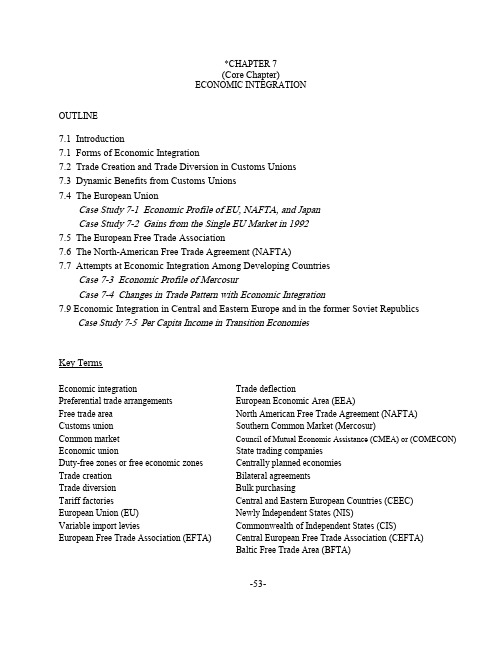
*CHAPTER 7(Core Chapter)INTEGRATIONECONOMICOUTLINE7.1 Introduction7.1 Forms of Economic Integration7.2 Trade Creation and Trade Diversion in Customs Unions7.3 Dynamic Benefits from Customs Unions7.4 The European UnionCase Study 7-1 Economic Profile of EU, NAFTA, and JapanCase Study 7-2 Gains from the Single EU Market in 19927.5 The European Free Trade Association7.6 The North-American Free Trade Agreement (NAFTA)7.7 Attempts at Economic Integration Among Developing CountriesCase 7-3 Economic Profile of MercosurCase 7-4 Changes in Trade Pattern with Economic Integration7.9 Economic Integration in Central and Eastern Europe and in the former Soviet RepublicsCase Study 7-5 Per Capita Income in Transition EconomiesKey TermsdeflectionTradeEconomicintegrationPreferential trade arrangements European Economic Area (EEA)Free trade area North American Free Trade Agreement (NAFTA)MarketCommon(Mercosur)SouthernCustomsunionmarket Council of Mutual Economic Assistance (CMEA) or (COMECON) Commoncompaniestradingunion StateEconomicDuty-free zones or free economic zones Centrally planned economiesagreementsBilateralTradecreationBulkpurchasingdiversionTradeandEastern European Countries (CEEC) factoriesCentralTariffNewly Independent States (NIS)(EU)EuropeanUnionVariable import levies Commonwealth of Independent States (CIS)European Free Trade Association (EFTA) Central European Free Trade Association (CEFTA)(BFTA)AreaBalticTradeFree-53-Lecture Guide:1. This is not a core chapter and I would skip it, except for sections 7-4 to 7-8 dealing with theEuropean Union (EU), The European Free Trade Association, the North American FreeTrade Agreement (NAFTA), and the Southern Common Market (Mercosur).2. I would take two classes to cover the material. Case Studies 7-1 to 7-4 can be used for a very stimulating class discussion.Answers to Problems:1. If Nation A imposes a 100 percent ad valorem tariff on imports of commodity X fromNation B and Nation C, Nation A will produce commodity X domestically because thedomestic price of commodity X is $10 as compared with the tariff-inclusive price of$16 if Nation A imported commodity X from Nation B and $12 if Nation A importedcommodity X from nation C.2. a. If Nation A forms a customs union with Nation B, Nation A will import commodityX from Nation B at the price of $8 instead of producing it itself at $10 or importing itfrom Nation C at the tariff-inclusive price of $12.b. The formation by Nation A of a customs union with Nation B leads to trade creationonly because Nation A replaces the domestic production of commodity X at Px=$10with tariff-free imports of commodity X from Nation B at Px=$8.3. If Nation A imposes a 50 percent ad valorem tariff on imports of commodity X fromNation B and Nation C, Nation A will import commodity X from nation C at the tariff-inclusive price of $9 instead of producing commodity X itself or importing it fromNation B at the tariff-inclusive price of $12.4. a. If Nation A forms a customs union with Nation B, Nation A will import commodityX from Nation B at the price of $8 instead of importing it from Nation C at the tariff- inclusive price of $9.b. The formation by Nation A of a customs union with Nation B leads not only to tradecreation but also to trade diversion because it replaces lower-cost imports of commodity X of $6 (from the point of view of Nation A as a whole) with higher priced imports of Commodity X from Nation B at $8.Specifically, Nation A's importers do not import commodity X from Nation C becausethe tariff-inclusive price of commodity X from Nation C is $9 as compared with theno-tariff price of $8 for imports of commodity X from Nation B. However, since thegovernment of Nation A collects the $3 tariff per unit on imports of commodity Xfrom Nation C, the net effective price for imports of commodity X from Nation C isreally $6 for Nation A as a whole.-54-5. a. See Figure 1 below.b. The net gain from the trade-diverting customs union shown in Figure 1 is given byC'JJ'+B'HH'-MJ'H'N. As contrasted with the case in Figure 7-1 in the text, however,the sum of the areas of the two triangles (measuring gains) is here greater than the area the rectangle (measuring the loss). Thus, the nation would now gain from the formation of a custom union. Had we drawn the figure on graph paper, we would have been able to measure the net gain in monetary terms also.6. A customs union that leads to both trade creation and trade diversion is more likely to lead to a net positive welfare gain of the nation joining the union (1) the smaller is the relative inefficiency of the union member in relation to the non-union member and (2) the higher is the level of the tariff imposed by the customs union on the non-union member.7. The dynamic benefits resulting from the formation of a customs union are (1) increasedcompetition, (2) economies of scale, (3) stimulus to investment, and (4) better utilizationof economic resources. These are likely to be much more significant than the static benefits.8. See Figure 2 below. The formation of the customs union has no effect.9. NAFTA created much more controversy because the very low wages in Mexico led togreat fears of large job losses in the U. S.10. The possible cost to the U.S. from EU92 arose from the increased efficiency andcompetitiveness of the E.U. The benefit arose because a more rapid growth in the EUspills into a greater demand for American products, which benefits the U. S.Fig 7.1xPFig 7.2xP-55-Multiple-choice Questions:1. Which of the following statements is correct?*a. in a customs union, member nations apply a uniform external tariffb. in a free-trade area, member nations harmonize their monetary and fiscal policiesc. within a customs union there is unrestricted factor movementd. a customs union is a higher form of economic integration than a common market2. A customs union that allows for the free movement of labor and capital among itsmember nations is called a:a. preferential trade arrangementb. free-trade area*c. common marketd. all of the above3. A customs union creates trade when:a. lower-cost imports from outside the customs union are replaced by higher-costimports from a union member*b. some domestic production in a member nation is replaced by lower-cost imports from another member nationc. trade among members increases but trade with nonmembers decreasesd. trade among members decreases while trade with nonmembers increases4. Trade diversion arises in a customs union if it:a. increases trade among union members and with nonmember nationsb. reduces trade among union members and with nonmember nations*c. increases trade among members but reduces trade with non-membersd. reduces trade among union members but increases it with nonmembers5. Customs union usually results in:a. trade diversion onlyb. trade creation only*c. both trade creation and trade diversiond. we cannot say-56-6. The formation of a customs union that leads only to trade creation and all economic resources of member nations are fully employed before and after the formation of the customs union leads to an:*a. increase in the welfare of member and nonmember nationsb. increase in the welfare of member nations onlyc. increase in the welfare of nonmember nations onlyd. increase or decrease in the welfare of member and nonmember nations7. A customs union that leads to both trade creation and trade diversion:a. increases the welfare of member and nonmember nationsb. reduces the welfare of member and nonmember nationsc. increases the welfare of member nations but reduces that of nonmembers*d. reduces the welfare of nonmembers and may increase or reduce that of members8. A customs union is more likely to lead to trade creation:a. the lower are the pre-union trade barriers of the member countries*b. the lower are the customs union's barriers on trade with the rest of the worldc. the smaller is the number of countries forming the customs union and the smallertheir sized. the more complementary rather than competitive are the economies of the nationsforming the customs union9. Which is not a dynamic benefit from the formation of a customs union?a. increased competitionb. economies of scalec. stimulus to investment*d. trade creation10. The formation of the EU resulted in:a. trade creation in industrial and agricultural productsb. trade diversion in industrial and agricultural products*c. trade creation in industrial products and trade diversion in agricultural productsd. trade diversion in industrial products and trade creation in agricultural products11. The benefit that the United States receives from NAFTA:*a. increasing competition in product and resource marketsb. greater technical innovationc. improvements in its terms of traded. all of the above-57-12. The benefit that Mexico is likely to receive from NAFTA:a. greater export-led growthb. encouraging the return of flight capitalc. more rapid structural change*d. all of the above13. Which is a stumbling block to successful economic integration among groups ofdeveloping nations?a. benefits are not evenly distributed among nationsb. many developing nations are not willing to relinquish part of their newly-acquiredsovereignty to a supranational community body, as required for successful economicintegrationc. the complementary nature of their economies and competition for the same worldmarkets for their agricultural exports*d. all of the above14. The formation of a free trade area among the countries of Eastern Europe is advocatedin order to:a. restore trade trading*b. retain the traditional trade links that can be justified on market principlesc. reduce the need for structural changed. none of the above15. The Members of Mercosur are:a. Brazil, Mexico, Argentina, and venezuelab. Argentina, Brazil, the United States and Peru*c. Brazil, Argentina, Paraguay, and Uruguayd. Brazil, Chile, Peru and Canada-58-。
国际经济学第十版答案

国际经济学第十版答案【篇一:国际经济学复习课后答案】1.为什么说生产和消费只取决于相对价格?答:经济主体的经济行为考虑的是所有商品的价格,而不是单一价格因素。
3.在只有两种商品的情况下,当一个商品达到均衡时,另外一个商品是否也同时达到均衡?试解释原因。
答案:是4.如果生产可能性边界是一条直线,试确定过剩供给(或需求)曲线。
答案提示:5.如果改用y商品的过剩供给曲线(b国)和过剩需求曲线(a国)来确定国际均衡价格,那么所得出的结果与图1—13中的结果是否一致?答案提示:不一定一致,x商品的价格是px/py,而y商品的价格是py/px.7.如果国际贸易发生在一个大国和一个小国之间,那么贸易后,国际相对价格更接近于哪一个国家在封闭下的相对价格水平?答案提示:贸易后,国际相对价格将更接近于大国在封闭下的相对价格水平。
8.根据上一题的答案,你认为哪个国家在国际贸易中福利改善程度更为明显些?答案提示:小国。
第二章答案1.根据下面两个表中的数据,确定(1)贸易前的相对价格;(2)比较优势型态。
表1 x、y的单位产出所需的劳动投入x y表2 x、y的单位产出所需的劳动投入ab 5 5a 6 2b 15 12x 10 y4答案提示:首先将劳动投入转化为劳动生产率,然后应用与本章正文中一样的方法进行比较。
(表2-2(a)和表2-2(b)部分的内容) 2.假设a、b两国的生产技术条件如下所示,那么两国还有进行贸易的动机吗?解释原因。
表3 x、y的单位产出所需的劳动投入x ya 4 2b 8 4答案提示:从绝对优势来看,两国当中a国在两种产品中都有绝对优势;从比较优势来看,两国不存在相对技术差异。
所以,两国没有进行国际贸易的动机。
3.如果一国在某一商品上具有绝对优势,那么也必具有比较优势吗?答案提示:不一定,比较优势的确定原则是两优取最优,两劣取最劣。
5.假设某一国家拥有20,000万单位的劳动,x、y的单位产出所要求的劳动投入分别为5个单位和4个单位,试确定生产可能性边界方程。
萨尔瓦多《国际经济学》(第10版)课后习题详解-第18章 开放经济宏观经济学:调整政策【圣才出品】
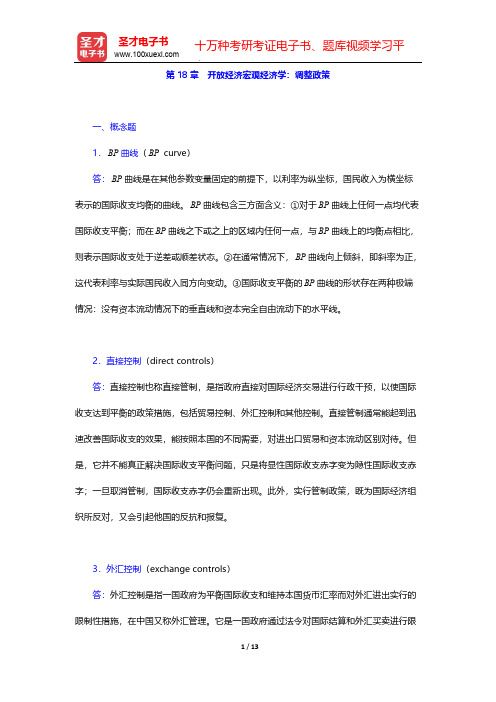
第18章 开放经济宏观经济学:调整政策一、概念题1.曲线( curve)BP BP答:曲线是在其他参数变量固定的前提下,以利率为纵坐标,国民收入为横坐标BP表示的国际收支均衡的曲线。
曲线包含三方面含义:①对于曲线上任何一点均代表BP BP国际收支平衡;而在曲线之下或之上的区域内任何一点,与曲线上的均衡点相比,BP BP则表示国际收支处于逆差或顺差状态。
②在通常情况下,曲线向上倾斜,即斜率为正,BP这代表利率与实际国民收入同方向变动。
③国际收支平衡的曲线的形状存在两种极端BP情况:没有资本流动情况下的垂直线和资本完全自由流动下的水平线。
2.直接控制(direct controls)答:直接控制也称直接管制,是指政府直接对国际经济交易进行行政干预,以使国际收支达到平衡的政策措施,包括贸易控制、外汇控制和其他控制。
直接管制通常能起到迅速改善国际收支的效果,能按照本国的不同需要,对进出口贸易和资本流动区别对待。
但是,它并不能真正解决国际收支平衡问题,只是将显性国际收支赤字变为隐性国际收支赤字;一旦取消管制,国际收支赤字仍会重新出现。
此外,实行管制政策,既为国际经济组织所反对,又会引起他国的反抗和报复。
3.外汇控制(exchange controls)答:外汇控制是指一国政府为平衡国际收支和维持本国货币汇率而对外汇进出实行的限制性措施,在中国又称外汇管理。
它是一国政府通过法令对国际结算和外汇买卖进行限制的一种限制进口的国际贸易政策。
外汇控制分为数量控制和成本控制。
前者是指国家外汇管理机构对外汇买卖的数量直接进行限制和分配,通过控制外汇总量达到限制出口的目的;后者是指,国家外汇管理机构对外汇买卖实行复汇率制,利用外汇买卖成本的差异,调节进口商品结构。
4.支出—改变政策(expenditure-changing policies)答:支出—改变政策是指政府通过财政政策来改变经济中对商品和劳务的总需求水平,从而实现内外均衡的政策。
ch05 国际经济学课后答案与习题(萨尔瓦多)
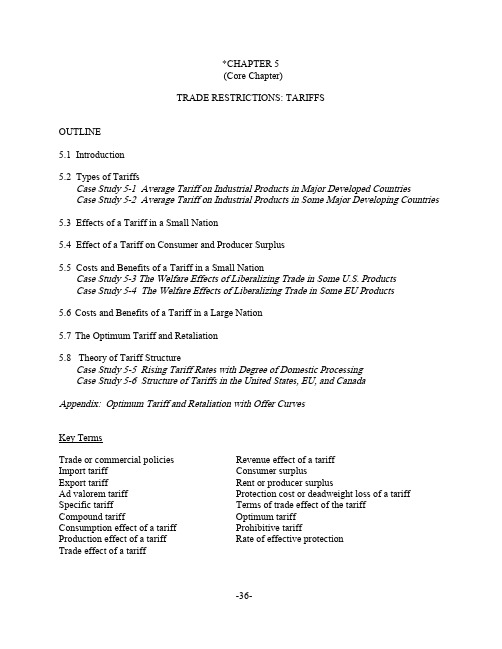
*CHAPTER 5(Core Chapter)TRADE RESTRICTIONS: TARIFFSOUTLINE5.1 Introduction5.2 Types of TariffsCase Study 5-1 Average Tariff on Industrial Products in Major Developed CountriesCase Study 5-2 Average Tariff on Industrial Products in Some Major Developing Countries 5.3 Effects of a Tariff in a Small Nation5.4 Effect of a Tariff on Consumer and Producer Surplus5.5 Costs and Benefits of a Tariff in a Small NationCase Study 5-3 The Welfare Effects of Liberalizing Trade in Some U.S. ProductsCase Study 5-4 The Welfare Effects of Liberalizing Trade in Some EU Products5.6 Costs and Benefits of a Tariff in a Large Nation5.7 The Optimum Tariff and Retaliation5.8 Theory of Tariff StructureCase Study 5-5 Rising Tariff Rates with Degree of Domestic ProcessingCase Study 5-6 Structure of Tariffs in the United States, EU, and CanadaAppendix: Optimum Tariff and Retaliation with Offer CurvesKey TermsTrade or commercial policies Revenue effect of a tariffsurplustariff ConsumerImportExport tariff Rent or producer surplustariff Protectioncost or deadweight loss of a tariff valoremAdSpecific tariff Terms of trade effect of the tarifftarifftariff OptimumCompoundConsumption effect of a tariff Prohibitive tariffProduction effect of a tariff Rate of effective protectionTrade effect of a tariffLecture Guide1. I would cover sections 1-4 in the first lecture. The most difficult part is Section 4 on themeaning and measurement of consumer and producer surplus. Since a clear understanding of the meaning and measurement of consumer and producer surplus is crucial in measuring the welfare effect of tariffs, I would explain these concepts very carefully.2. I would cover sections 5 and 6 in the second lecture. These are the most difficult sections inthe chapter and also the most important.3. The theory of tariff structure is also difficult and important. I found that the best way toexplain it is by using the simple example in the text on the suit with and without imported inputs. This section is likely to generate a great deal of discussion about the trade relations between developed and developing nations. If you do not plan to cover optional Chapter 8 on growth and development, you could spend a bit more time on this topic here , even though it will come up again in Chapter 6.Answer to Problems1. a. See Figure 1 on the next page.b. Consumption is 70X, production is 50X and imports are 20X.c. The consumption effect is –30X, the production effect is +30X, the trade effectis –60X, and the revenue effect is $30 (see Figure 1).2. a. The consumer surplus is $250 without and $l22.50 with the tariff (see Figure 1).b. Of the increase in the revenue of producers with the tariff (as compared with theirrevenues under free trade), $22.50 represents the increase in production costs andanother $22.50 represents the increase in rent or producer surplus (see Figure 1).c. The dollar value or the protection cost of the tariff is $45 (see Figure 1).3. The dollar value or the protection cost of the tariff is $45 (see Figure 2).4. The dollar value or the protection cost of the tariff is $45 (see Figure 3).5. The optimum tariff is the tariff that maximizes the net benefit resulting from theimprovement in the nation’s terms of trade against the negative effect resulting fromreduction in the volume of trade.X Fig 5.1X Fig 5.2XFig 5.36. a. When a nation imposes an optimum tariff, the trade partner’s welfare declines because ofthe lower volume of trade and the deterioration in its terms of trade.b. The trade partner is likely to retaliate and in the end both nations are likely to lose becauseof the reduction in the volume of trade.7. Even when the trade partner does not retaliate when one nation imposes the optimum tariff,the gains of the tariff-imposing nation are less than the losses of the trade partner, so that theworld as a whole is worse off than under free trade. It is in this sense that free trade maximizesworld welfare.8. a. The nominal tariff is calculated on the market price of the product or service. The rate ofeffective protection, on the other hand, is calculated on the value added in the nation. It isequal to the value of the price of the commodity or service minus the value of the importedinputs used in the production of the commodity or service.b. The nominal tariff is important to consumers because it determines by how much the priceof the imported commodity increases. The rate of effective protection is important fordomestic producers because it determines the actual rate of protection provided by thetariff to domestic processing.9. a. Rates of effective protection in industrial nations are generally much higher than thecorresponding nominal rates and increase with the degree of processing.b. The tariff structure of developed nations is of great concern for developing nationsbecause it discourages manufacturing production in developing nations.10. If a nation reduces the nominal tariff on the importation of the raw materials required toproduce a commodity but does not reduce the tariff on the importation of the finalcommodity produced with the imported raw material, then the effective tariff rates willincrease relative to the nominal tariff rate on the commodity.Multiple-choice Questions1. Which of the following statements is incorrect?a. an ad valorem tariff is expressed as a percentage of the price of the traded commodity.b. a specific tariff is expressed as a fixed sum of the value of the traded commodity.c. export tariffs are prohibited by the U.S. Constitution*d. the U.S. uses exclusively the specific tariff2. A small nation is one:a. which does not affect world price by its tradingb. which faces an infinitely elastic world supply curve for its import commodityc. whose consumers will pay a price that exceeds the world price by the amount of the tariff *d. all of the above3. If a small nation increases the tariff on its import commodity, its:a. consumption of the commodity increasesb. production of the commodity decreasesc. imports of the commodity increase*d. none of the above4. The increase in producer surplus when a small nation imposes a tariff is measured by the area: *a. to the left of the supply curve between the commodity price with and without the tariffb. under the supply curve between the quantity produced with and without the tariffc. under the demand curve between the commodity price with and without the tariffd. none of the above.5. If a small nation increases the tariff on its import commodity:*a. the rent of domestic producers of the commodity increasesb. the protection cost of the tariff decreasesc. the deadweight loss decreasesd. all of the above6. The imposition of an optimum tariff by a small nation:a. improves its terms of tradeb. reduces the volume of tradec. increases the nation's welfare*d. non of the above7. The optimum tariff for a small nation is:a. 100%b. 50%*c. 0d. depends on the elasticity of demand and supply for the import commodity in the nation8. The imposition of an optimum tariff by a large nation:a. improves its terms of tradeb. reduces the volume of tradec. increases the nation's welfare*d. all of the above9. The imposition of an optimum tariff by a large nation:a. improves the terms of trade of the trade partner*b. reduces the volume of tradec. increases the trade partner’s welfared. all of the above10. If two large countries impose an optimum tariff*a. the welfare of the both nations decreaseb. the welfare of the both nations increasec. the welfare of the larger nation will increase and that of the other nation decreasesd. the welfare of the larger nation will decrease and that of the other nation increases11. If one nation imposes an optimum tariff and the other nation does not retaliate*a. the welfare of the first nation increases and that of the welfare of the second nation fallsb. the welfare of the second nation increases and that of the welfare of the second nation fallsc. the welfare of both nations falld. the welfare of both nations increase12. If one nation imposes an optimum tariff and the other nation does not retaliatea. the welfare of the first nation increases more than the fall in the welfare of the secondnation*b. the welfare of the first nation increases more than the fall in the welfare of the secondnationc. the welfare of the second nation increases less than the fall in the welfare of the firstnationd. the welfare of the first nation increases by the same amount as the fall in the welfare of the second nation13. The nominal tariff is the tariff calculated on thea. price of the input used in the production of the commodity*b. price of the commodity or servicec. value addedd. all of the above14. The effective tariff rate is the tariff calculated on thea. price of the input used in the production of the commodityb. commodity or service*c. value added in the nationd. all of the above15. If the nominal tariff on a commodity is higher than the nominal tariff on the imported input used in the production of the commodity, then the rate of effective protection is*a. higher on the commodity than on the inputb. lower on the commodity than on the imported inputc. equal on the commodity and on the imported inputd. any of the above。
(完整word版)《国际经济学》课后思考题(纯文字答案题目)
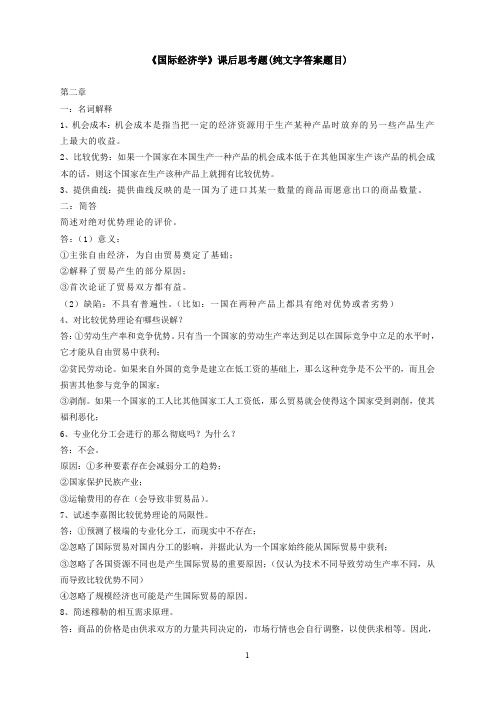
《国际经济学》课后思考题(纯文字答案题目)第二章一:名词解释1、机会成本:机会成本是指当把一定的经济资源用于生产某种产品时放弃的另一些产品生产上最大的收益。
2、比较优势:如果一个国家在本国生产一种产品的机会成本低于在其他国家生产该产品的机会成本的话,则这个国家在生产该种产品上就拥有比较优势。
3、提供曲线:提供曲线反映的是一国为了进口其某一数量的商品而愿意出口的商品数量。
二:简答简述对绝对优势理论的评价。
答:(1)意义:①主张自由经济,为自由贸易奠定了基础;②解释了贸易产生的部分原因;③首次论证了贸易双方都有益。
(2)缺陷:不具有普遍性。
(比如:一国在两种产品上都具有绝对优势或者劣势)4、对比较优势理论有哪些误解?答:①劳动生产率和竞争优势。
只有当一个国家的劳动生产率达到足以在国际竞争中立足的水平时,它才能从自由贸易中获利;②贫民劳动论。
如果来自外国的竞争是建立在低工资的基础上,那么这种竞争是不公平的,而且会损害其他参与竞争的国家;③剥削。
如果一个国家的工人比其他国家工人工资低,那么贸易就会使得这个国家受到剥削,使其福利恶化;6、专业化分工会进行的那么彻底吗?为什么?答:不会。
原因:①多种要素存在会减弱分工的趋势;②国家保护民族产业;③运输费用的存在(会导致非贸易品)。
7、试述李嘉图比较优势理论的局限性。
答:①预测了极端的专业化分工,而现实中不存在;②忽略了国际贸易对国内分工的影响,并据此认为一个国家始终能从国际贸易中获利;③忽略了各国资源不同也是产生国际贸易的重要原因;(仅认为技术不同导致劳动生产率不同,从而导致比较优势不同)④忽略了规模经济也可能是产生国际贸易的原因。
8、简述穆勒的相互需求原理。
答:商品的价格是由供求双方的力量共同决定的,市场行情也会自行调整,以使供求相等。
因此,商品的国际交换比率就是由两国相互的需求来决定的,并且将确定在双方各自对对方产品需求相等的水平上,这就是相互需求原理。
萨尔瓦多《国际经济学》课后习题详解(国际货币体系:过去、现在与未来)【圣才出品】

第21章国际货币体系:过去、现在与未来一、概念题1.调整(adjustment)答:调整是评价国际货币体系好坏的标准之一,是指国际货币体系纠正国际收支失衡的过程。
一个好的国际货币体系应该使调整成本和所需时间最小。
2.善意忽视(benign neglect)答:善意忽视是指在浮动汇率制度中,货币当局对汇率采取的一种相对放任的态度,较少地对外汇市场进行干预,而由货币本身价值的变化自动调节国际收支状况。
3.布雷顿森林体系(Bretton Woods System)答:布雷顿森林体系是第二次世界大战即将结束时创立的国际货币体系。
该体系是根据《国际货币基金协定》创立的。
主要特点是:规定美元与黄金挂钩,确认美国1934年1月规定的1美元含金量为0.888671克,即35美元=1盎司黄金;规定其他各国货币按含金量同美元挂钩;市场汇率的波动幅度若超过平价上下1%,各国政府有义务进行市场干预;平价变动幅度如超过10%时则须得到国际货币基金组织的同意,由此形成了固定汇率制度,促进了国际贸易与金融关系的发展。
20世纪60年代频繁爆发的美元危机削弱了布雷顿森林体系,并迫使美国政府于1971年8月15日宣布停止美元兑换黄金。
1973年3月起,主要西方国家相继实行浮动汇率制,布雷顿森林体系正式宣告瓦解。
4.可靠性(confidence)答:可靠性是评价国际货币体系好坏的标准之一,是指国际货币体系调节机制具有正常运行的自动机制,能够保持国际储备的绝对价值和相对价值。
5.信用份额(credit tranches)答:信用份额是指国际货币基金组织为其成员国提供不受任何限制或附加条件约束的贷款的额度。
一般来说,一个成员国一年内的借款不得超过其配额的25%,每5年的借款总额不得超过其配额的125%,在此范围内,这些借款可自动获得。
当一国的借款超过所设定的信用份额时,国际货币基金组织就要收取越来越高的利息,而且进行越来越严格的监督,附加越来越多的条件,以确保该逆差国正在采取正确的措施以消除其赤字。
萨尔瓦多国际经济学第三章课后练习题答案

1.在一个坐标系内,画一条凹向原点的生产可能性曲线:(1)从生产可能性曲线的中点开始用箭头表示该国在生产更多X(横轴表示的商品)和更多Y时所发生的机会成本递增情况。
(2)当生产更多的X时,生产可能性曲线的斜率如何变化?生产更多的Y呢?这种变化反映了什么?答:(1)图1 生产可能性曲线(3)如上图所示,当生产更多的X时,生产可能性曲线的斜率变大;当生产更多的Y时,生产可能性曲线的斜率变大。
原因是当该国生产更多的X或Y时,机会成本会变大。
2.在另一个坐标系内,画三条社会无差异曲线,并令最高的两条相交:(1) 社会无差异曲线为什么向下倾斜,或者说斜率为负?(2)曲线的斜率代表什么?为什么每条无差异曲线在较低点斜率较小?(3)考虑相交的两条无差异曲线,是在交点右边的还是在交点左边的曲线表示的满足程度较高?为什么和无差异曲线的定义不一致?你可以得出什么结论?答:图2 社会无差异曲线(1)社会无差异曲线之所以会向下倾斜是因为为了维持社会福利水平不变,随着X商品消费的增加必须减少Y的消费。
(2)曲线的斜率代表一国在保持处在同一条无差异曲线的前提下,多消费一单位x而必须少消费Y的数量。
一国消费X越多,则其消费Y越少。
对该国来说,一单位Y的效用会逐渐增大。
因此,该国每多消费一单位X,只会放弃越来越少的Y商品。
所以,无差异曲线在较低点斜率较小。
(3)无差异曲线的定义表明每条无差异曲线意味着一个给定的满足程度,无差异曲线互不相交。
无差异曲线II显示了比交点右边更高的满足程度,无差异曲线II显示了比交点左边更高的满足程度。
因此,这个图是不合理。
3.在一个坐标系内,画一条生产可能性曲线,再画一条无差异曲线切于生产可能性曲线较平坦的地方,在另一个坐标系内,面另一条生产可能性曲线,再画另一条无差异曲线切于生产可能性曲线较陡直的地方。
(1)画一条表示各国孤立均衡相对价格的直线。
(2)各国具有比较优势的商品分别是什么?(3)在什么(极端)情况下,两国之间不存在比较优势或比较劣势?答:国家1 国家2图3 孤立均衡(1)如图3所示,P A和P A’是两国在孤立均衡情况下的价格。
ch04国际经济学课后答案与习题萨尔瓦多

ch04国际经济学课后答案与习题萨尔瓦多国际经济学视角下的萨尔瓦多在国际经济学的广袤领域中,萨尔瓦多作为一个中美洲的国家,具有独特的经济特征和在全球经济格局中的地位。
萨尔瓦多的经济发展历程充满了挑战与机遇。
从传统的农业经济为主,逐渐向多元化的经济结构转变。
农业曾经是其经济的支柱,咖啡、棉花等农产品在国际市场上有一定的份额。
然而,随着时间的推移,萨尔瓦多开始注重发展制造业和服务业,以减少对农业的依赖。
在国际贸易方面,萨尔瓦多面临着诸多问题。
其出口产品相对单一,缺乏高附加值的商品。
这使得萨尔瓦多在国际贸易中处于相对弱势的地位,容易受到国际市场波动和贸易保护主义的影响。
同时,萨尔瓦多的贸易伙伴相对集中,主要是美国和中美洲的一些邻国。
这种贸易结构的单一性增加了经济的风险。
在国际金融领域,萨尔瓦多的货币汇率波动对其经济稳定产生了一定的影响。
萨尔瓦多曾经长期使用美元作为法定货币,这在一定程度上稳定了金融市场,但也削弱了本国货币政策的自主性。
此外,国际资本的流动对萨尔瓦多的金融市场也带来了冲击,尤其是在全球金融危机期间,外资的撤离给其经济造成了不小的压力。
从国际投资的角度来看,萨尔瓦多在吸引外资方面做出了不少努力。
政府出台了一系列优惠政策,试图吸引更多的外国直接投资。
然而,由于基础设施不完善、劳动力素质有待提高等因素,萨尔瓦多在吸引大规模、高质量的外资方面仍面临困难。
萨尔瓦多的经济还受到国际经济环境变化的深刻影响。
例如,全球经济增长放缓会导致对萨尔瓦多出口商品的需求减少,从而影响其经济增长。
而国际原材料价格的波动也会对萨尔瓦多的相关产业造成冲击。
在区域经济合作中,萨尔瓦多积极参与中美洲一体化体系等区域组织,试图通过加强区域内的贸易和投资合作来促进自身经济发展。
然而,区域内各国经济发展水平参差不齐,合作机制也存在一些不完善之处,这在一定程度上限制了区域合作对萨尔瓦多经济的推动作用。
为了实现经济的可持续发展,萨尔瓦多需要在多个方面采取措施。
国际经济学第十版课后标准答案-(萨尔瓦多、杨冰译)

国际经济学第十版课后答案-(萨尔瓦多、杨冰译)————————————————————————————————作者:————————————————————————————————日期:国际经济学(第十版)多米尼克.萨尔瓦多(著)P16页练习题6.(1)根据消费者需求理论,当其他条件不变时,一种商品价格的提高(如由于税率的上浮所致),会带来需求量的什么变化?答:根据消费者需求理论,当其他条件不变时,一种商品价格的提高,则该商品的需求量将会下降。
(2)根据消费者需求理论,一种进口商品价格的提高(如由于进口关税的上浮所致),会带来需求量的什么变化?答:根据消费者需求理论,一种进口商品价格的提高,则该商品的出口量将会下降。
7.(1)一国政府如何能消除或减少预算赤字?答:一国政府可以通过减少政府支出、增加税收,来消除或者减少预算赤字。
(2)一个国家如何能消除或减少贸易逆差?答:一个国家要消除或减少其贸易逆差的方式有:对进口商品增税、补贴出口,借如更多的国外债券、减少借出外国债券,降低该国的国民收入水平。
8.(1)国际经济关系与地区经济关系有何区别?答:在国际经济关系下,国家通常限制在国际间的自由流动的货物、服务和因素,不同的语言、消费习惯和法律规定同样也阻碍了它们在国际间的流动,此外,国际收支会在各种货币收据和付款中流通。
而在地区经济关系下,就关税和进行相同的货币而言,区际流动的货物、服务和因素没有面临这样的限制因素,它们经常是在同样的语言环境下,在类似的消费习惯和法律规定下进行的,这就与国际经济关系形成了鲜明对比。
(2)它们在哪方面相似?答:国际经济关系和地区经济关系的相似点:两者都跨越了空间距离,事实上,它们都是在远距离贸易下的产物,把经济看待成在一个进行着生产、交换和消费的空间中的单一点,这也是从经济学的复位空间将它们区分。
10.如果说一个国家可以从国际贸易中获益,那么你如何解释为什么许多国家又要对国际贸易施加某些限制?答:国际贸易给本国消费者带来的是更低的价格,这样就会对本国的同种商品的生产商造成不利,挤兑了本国生产商的销售份额。
ch06 国际经济学课后答案与习题(萨尔瓦多)

*CHAPTER6Chapter) (Core NONTARIFF TRADE BARRIERS AND THE POLITICAL ECONOMY OF PROTETIONISM OUTLINE6.1 Introduction6.2 Import Quotas6.3 Other Nontariff Trade BarriersCase Study 6-1 Voluntary Export Restraints on Japanese Automobiles to the United States6.4 Dumping and Export SubsidiesCase Study 6-2 Antidumping Measures in Force in 2002Case Study 6-3 Agricultural Subsidies in Developed NationsCase Study 6-4 Pervasiveness of Nontariff Barriers6.5 The Political Economy of Protectionism6.6 Strategic Trade and Industrial PoliciesCase Study 6-5 Economic Effects on the U.S. Economy from Removing all Import Restraints6.7 History of U.S. Commercial Policy6.8 The Uruguay RoundCase Study 6-6 The Multilateral Rounds of Trade Negotiations6.9 Outstanding Trade Problems and the Doha RoundAppendix: Strategic Trade and Industrial Policies with Game TheoryKey Termsprinciple Most-favored-nationQuotaNontariff trade barriers (NTBs) Bilateral tradeprotectionism General Agreement on Tariffs and Trade (GATT) NewVoluntary export restraints (VERs) Multilateral trade negotiationsTechnical, administrative, and other regulations Peril-point provisionsclausecartel EscapeInternationalclauseDumping NationalsecurityPersistent dumping Trade Expansion Act of 1962Trade adjustment assistance (TAP)Predatorydumpingdumping KennedyRoundSporadicTrigger-price mechanism Trade Reform Act of 1974RoundExportsubsidies TokyoExport-Import Bank Trade and Tariff Act of 1984Foreign Sales Corporations Omnibus Trade and Competitiveness Act of 1988UruguayRound(CVDs)dutiesCountervailingOrganization(WTO)TradeWorldScientifictariffpromotion authority or fast trackInfant-industryargument TradepolicyRoundDohatradeStrategicmovement policy AntiglobalizationIndustrialtheoryAct GameSmoot–HawleyTariffTrade Agreements Act of 1934-43-Lecture Guide:1. This is an important core chapter examining some of the most recent developments ininternational trade policy.2. I would cover sections 1-3 in lecture 1. I would pay particular attention to Figure 6-1,which examines the partial equilibrium effects of an import quota. I would also clearlyexplain the difference between a regular import quota and a voluntary export restraint.3. I would cover sections 4 and 5 in lecture 2. I would also clearly explain the meaningand importance of dumping and export subsidies, as well as the political economy ofprotectionism. The four case studies serve to highlight the theory and show the relevance of the theory in today's world.4. The rest of the chapter can be covered in lecture 3. Strategic trade and industrial policies, thehistory of U.S. commercial policy, and the outstaying trade problems and the collapse of the Doha Round of trade negotiations in September 2003 should not be difficult to explain and can lead to a great deal of interesting class discussion.Answer to Problems:1. a. An import quota will increase the price of the product to domestic consumers, reduce the domestic consumption of the good, increase domestic production, and result in a protection or deadweight loss to the economy.b. The effects of an import quota are identical to those of an equivalent import tariff, except that with a quota the government does not collect a tariff revenue (unless it auctions offimport quotas to the highest bidder). The import quota is also more restrictive than anequivalent import tariff because foreign producers cannot increase their exports bylowering their prices.2. By penciling in D”X in Figure 1, we can see that the effects of the import quota are:P x=$2.00 and consumption is 60X, of which 40X are produced domestically and 20X areimported; by auctioning off import licenses, the revenue effect would be $20.3. The effects of an export quota of 20X are identical to those of an import quota of 20X or a100 percent import tariff on commodity X, except that the revenue effect is collected by the exporters, rather than by the domestic importers or their government.4. a. An international cartel is an organization of suppliers of a commodity located in different nations (or it is a group of governments) that agrees to restrict output and the exports of the commodity with the aim of maximizing or increasing the total profits of its members.Although domestic cartels are illegal in the United States and are restricted in Europe, the power of international cartels cannot easily be countered because they do not fall under the jurisdiction of any one nation.b. The most notorious of present-day international cartels is OPEC (Organization ofPetroleum Exporting Countries), which, by restricting production and exports, succeeded in quadrupling the price of crude oil between 1973 and 1974. The economic power ofOPEC declined during the 1980s and 1990s when many other nations (such as Russia,Mexico, Norway, the United Kingdom) encouraged by the sharp increase in prices started to extract and export petroleum.5. a. Dumping refers to the export of a commodity at below cost or at a lower price than thecommodity is sold domestically.b. Dumping is classified as persistent, predatory, and sporadic. Persistent dumping, orinternational price discrimination, refers to the continuous sale of the commodity at ahigher price in the domestic market than internationally . The incentive for persistentdumping is the higher profits it provides to domestic producers.Predatory dumping is the temporary sale of a commodity at below cost or at a lower priceabroad than at home in order to drive foreign producers out of business, after which prices are raised to maximize profits. Sporadic dumping is the occasional sale of a commodity at below cost or at a lower price abroad than domestically in order to unload an unforeseenand temporary surplus of the commodity without having to reduce domestic prices.c. Dumping usually leads to trade restrictions as nations try to protect domestic producersfrom “unfair” foreign competition, even when the dumping is persistent and sporadic.6. a. One fallacious argument is that trade restrictions are needed to protect domestic laboragainst cheap foreign labor. This argument is not valid because even if domestic wagesare higher than wages abroad, domestic labor costs can still be lower if the productivity of labor is sufficiently higher domestically than abroad. If not, expensive-labor nations canstill specialize in the production and export capital- and technology-intensive commodities.b. Another fallacious argument for protection is the scientific tariff. This is the tariff rate that would make the price of imports equal to domestic prices and (so the argument goes) allow domestic producers to meet foreign competition. However, this would eliminate internatio- nal price differences and trade in commodities subject to such “scientific” tariffs.7. a. The infant-industry argument postulates that temporary protection may be justified in order to allow a developing nation to develop an industry in which it has a potential comparative advantage. Temporary trade protection is then justified to establish and protect the domestic industry during its “infancy” until it can grow and meet foreign competition. For thisargument to be valid, however, protection must be temporary and the return in the grown-up industry must be sufficiently high to also offset the higher prices paid by domesticconsumers of the commodity during the period of infancy.b. The infant-industry argument must be qualified in several important ways to be acceptable. First, this argument is more justified for developing nations (where capital markets maynot function properly) than for industrial nations. Second, it is usually difficult to identifywhich industry or potential industry qualifies for this treatment, and experience has shown that protection, once given, is difficult to remove. Third, and most important, what tradeprotection (say in the form of an import tariff) can do, an equivalent production subsidy to the infant industry can do better.8. a. According to strategic industrial trade policy a nation can create a comparative advantage(through temporary trade protection, subsidies, tax benefits, and cooperative government– industry programs) in a high-technology field deemed crucial to future growth in the nation.b. There are also serious difficulties in carrying strategic industrial and trade policies. First, itis extremely difficult to pick winners (i.e., choose the industries that will contribute significantly to growth in the future). Second, if most leading nations undertake strategic trade policies at the same time, their efforts are largely neutralized. Third, when a country does achieve substantial success with a strategic trade policy, this comes at the expense of other countries (i.e., it is a beggar-thy-neighbor policy), which are, therefore, likely to retaliate. Faced with all these practical difficulties, even supporters of strategic trade policy grudgingly acknowledge that free trade is still the best policy, after all.9. a. The main provisions of the Uruguay Round were the reduction of average tariffs onindustrial goods from 4.7 percent to 3 percent, for quotas to be replaced by tariffs, and for antidumping and safeguards to be tightened. The agreement also called for the reduction in agricultural export subsidies and industrial subsidies, and for the protection of intellectual property.b. When fully implemented by 2005, the Uruguay Round is estimated to increase world tradeby about 20 percent (with one quarter of the increase in trade in manufactures and the rest in agriculture) and generate total gains in world income of $349 billion ($164 billion from liberalizing trade in agriculture, $130 billion from manufactures and $55 billion fromservices), with developing countries receiving 42 percent of the total gains (mostly fromliberalization of trade in manufactures), which is roughly double their share of world GDP.10. a. The major trade problems facing the world today are (1) the serious trade disputes amongthe United States, the European Union, and Japan; (2) the high trade protectionism, especially in agriculture and textiles, which are of great importance to developing countries, and the abuse antidumping and safeguards; (3) the breaking up of the world into a few major trading blocks, and a serious anti-globalization movement that has come into existence.b. The Doha Round is needed to take up all of the above problems. However, as of the endof 2003 no negotiating agenda had been decided primarily because of disagreements on agricultural protectionism between developing and developed countries.-46-Multiple-choice Questions:1. An import quota:a. increases the domestic price of the imported commodityb. reduces domestic consumptionc. increases domestic production*d. all of the above2. An increase in the demand of the imported commodity subject to a given import quota:a. reduces the domestic quantity demanded of the commodity*b. increases the domestic production of the commodityc. reduces the domestic price of the commodityd. reduces the producers' surplus3. Adjustment to any shift in the domestic demand or supply of an importable commodityoccurs:a. in domestic price with an import quotab. in the quantity of imports with a tariffc. through the market mechanism with an import tariff but not with an import quota*d. all of the above4. An international cartel refers to:a. dumping*b. an organization of exportersc. an international commodity agreementd. voluntary export restraints5. The temporary sale of a commodity at below cost or at a lower price abroad in order todrive foreign producers out of business is called:*a. predatory dumpingb. sporadic dumpingc. continuous dumpingd. voluntary export restraints6. The type of dumping which would justify antidumping measures by the country subjectto the dumping is:*a. predatory dumpingb. sporadic dumpingc. continuous dumpingd. all of the above7. A fallacious argument for protection is:a. the infant industry argumentb. protection for national defense*c. the scientific tariffd. to correct domestic distortions8. Which of the following is true with respect to the infant-industry argument for protection:a. it refers to temporary protection to establish a domestic industryb. to be valid, the return to the grown-up industry must be sufficiently high also to repayfor the higher prices paid by domestic consumers of the commodity during the infancyperiodc. is inferior to an equivalent production subsidy to the infant industry*d. all of the above9. Which of the following is false with respect to strategic trade policy?a. it postulates that a nation can gain by an activist trade policy*b. it is practiced to some extent by most industrial nationsc. it can easily be carried outd. all of the above10. Industrial policy refers to:a. an activist policy by the government of an industrial country to stimulate thedevelopment of an industryb. the granting of a subsidy to a domestic industry to stimulate the development of anindustryc. the granting of a subsidy to a domestic industry to counter a foreign subsidy*d. all of the above11. Trade protection in the United States is usually provided to:a. low-wage workersb. well-organized industries with large employmentc. industries producing consumer products*d. all of the above12. The most-favored-nation principle refers to:*a. extension to all trade partners of any reciprocal tariff reduction negotiated by theU.S. with any of its trade partnersb. multilateral trade negotiationc. the General Agreement on Tariffs and Traded. the International Trade Organization13. On which of the following principles does GATT rest?a. nondiscriminationb. elimination of nontariff barriersc. consultation among nations in solving trade disputes*d. all of the above14. Which of the following was not negotiated under the Uruguay Round?a. reduction of tariffs on industrial goodsb. replacement of quotas with tariffsc. reduction of subsidies on industrial products and on agricultural exports *d. liberalization in trade in most services15. Game theory refers to:*a. a method of choosing the optimal strategy in conflict situationsb. the granting of a subsidy to correct a domestic distortionc. the theory of tariff protectiond. none of the aboveADDITIONAL ESSAYS AND PROBLEMS FOR PART TWO1. From the following figure, in which Dc and Sc refer, respectively to the domesticdemand and supply curves of cloth, and S F and S F+T refer, respectively, to the worldsupply curve of cloth under free trade and with a 50% import tariff imposed by the nation on the importation of cloth, determine:P CFig 6.1(a) the consumption, production effect, and the trade effect of the tariff.(b) the reduction in consumer surplus, the increase in producer surplus or rent, the tariff revenue, and the protection cost or deadweight loss to the economy as a result of the tariff.Answ. (a) The consumption effect is equal to BR=-20c;the production effect is equal to GN=20C;therefore, the trade effect is equal to -(BR+GN)=-40c.(b) The reduction in consumer surplus is FJHB=$90;the increase in producer surplus is FJMG=$30;the revenue effect is NMHR=$40;the protection cost or deadweight loss to the economy is equal to the sum of the area of triangles GMN and BHR or $20.2. (a) Explain why and under what conditions the infant-industry argument for an importtariff is valid.(b) How must this argument be qualified?Answ. (a) The infant-industry argument for tariffs is generally valid, especially for less developed countries (LDCs). It holds that an LDC may have a potential comparative advantage in a particular commodity, say textiles, but that because its initial production costs are too high (due to lack of know-how and the initial small level of output), this industry cannot be established or grow in the LDC in the face of foreign competition. An import tariff is then justified to help the LDC establish the industry and protect it during its "infancy," until the industry has grown in size and efficiency and is able to meet foreigncompetition. At that time, the tariff is to be removed.(b) In order for the infant-industry argument to be valid, not only must the tariff eventuallybe removed and the "grown up" industry be able to compete with foreign firms without protection, but the extra return in the industry (after the removal of the protection) must be high enough to justify the costs involved during the period of protection. These costs arise because the commodity is produced domestically rather than imported for less. It may also be difficult a priori to determine which industry or potential industry qualifies for this treatment, and to eventually remove the tariff once it is imposed. Economistsalso agree that what a tariff can do here, a direct subsidy to the infant industry can dobetter. This is because a subsidy can be varied so as to provide the infant industry with the same degree of protection as an equivalent import tariff but without distortingrelative prices and domestic consumption. However, a subsidy requires revenue, rather than generating it as the tariff does.-51-3. (a) How can strategic trade policy justify trade protection?(b) What difficulties arise in carrying out a strategic trade policy?Answ. (a) According to strategic trade policy, a nation can create a comparative advantage through temporary trade protection in such fields as semiconductors, computers, telecommunica- tions, and other industries that are deemed crucial to future growth in the nation. These high-technology industries are subject to high risks, require large-scale production toachieve economies of scale and give rise to extensive external economies whensuccessful. Strategic trade policy suggests that by encouraging such industries, thenation can enhance its future growth prospects. This is similar to the infant-industryargument in developing nations, except that it is advanced for industrial nations toacquire a comparative advantage in crucial high-technology industries. Most nationsdo some of this. Indeed, some economists would go so far as to say that a great dealof the postwar industrial and technological success of Japan is due to its strategicindustrial and trade policies.(b) There are three serious difficulties in carrying out strategic trade policy. First,it is extremely difficult to pick winners (i.e., choose the industries that will providelarge external economies in the future) and devise appropriate policies to successfullynurture them. Second, since most leading nations undertake strategic trade policies atthe same time, their efforts are largely neutralized so that the potential benefits to each may be small. Third, when a country does achieve substantial success with strategictrade policy, this comes at the expense of other countries (i.e., it is a beggar-thy-neighbor policy) and so other countries are likely to retaliate. Faced with all thesepractical difficulties, even supporters of strategic trade policy grudgingly acknowledge that free trade is still the best policy, after all.-52-。
国际经济学第版课后答案萨尔瓦多杨冰译
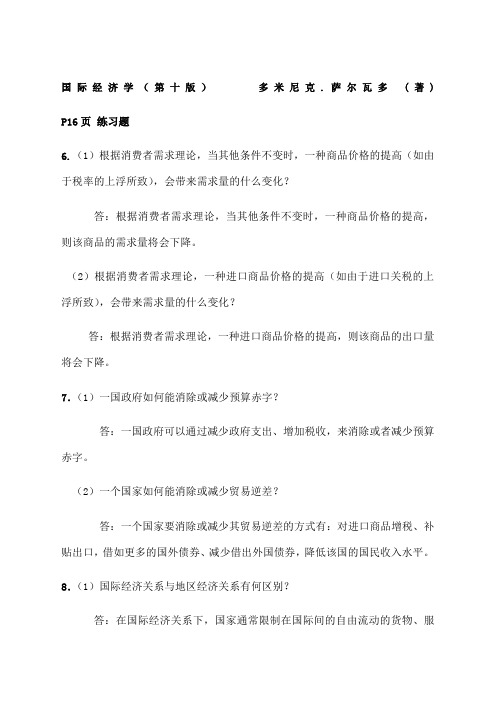
国际经济学(第十版)多米尼克.萨尔瓦多(著) P16页练习题6.(1)根据消费者需求理论,当其他条件不变时,一种商品价格的提高(如由于税率的上浮所致),会带来需求量的什么变化?答:根据消费者需求理论,当其他条件不变时,一种商品价格的提高,则该商品的需求量将会下降。
(2)根据消费者需求理论,一种进口商品价格的提高(如由于进口关税的上浮所致),会带来需求量的什么变化?答:根据消费者需求理论,一种进口商品价格的提高,则该商品的出口量将会下降。
7.(1)一国政府如何能消除或减少预算赤字?答:一国政府可以通过减少政府支出、增加税收,来消除或者减少预算赤字。
(2)一个国家如何能消除或减少贸易逆差?答:一个国家要消除或减少其贸易逆差的方式有:对进口商品增税、补贴出口,借如更多的国外债券、减少借出外国债券,降低该国的国民收入水平。
8.(1)国际经济关系与地区经济关系有何区别?答:在国际经济关系下,国家通常限制在国际间的自由流动的货物、服务和因素,不同的语言、消费习惯和法律规定同样也阻碍了它们在国际间的流动,此外,国际收支会在各种货币收据和付款中流通。
而在地区经济关系下,就关税和进行相同的货币而言,区际流动的货物、服务和因素没有面临这样的限制因素,它们经常是在同样的语言环境下,在类似的消费习惯和法律规定下进行的,这就与国际经济关系形成了鲜明对比。
(2)它们在哪方面相似?答:国际经济关系和地区经济关系的相似点:两者都跨越了空间距离,事实上,它们都是在远距离贸易下的产物,把经济看待成在一个进行着生产、交换和消费的空间中的单一点,这也是从经济学的复位空间将它们区分。
10.如果说一个国家可以从国际贸易中获益,那么你如何解释为什么许多国家又要对国际贸易施加某些限制?答:国际贸易给本国消费者带来的是更低的价格,这样就会对本国的同种商品的生产商造成不利,挤兑了本国生产商的销售份额。
通常在这种情况下,本国的生产商就会失去大量的订单,并且向政府提议限制进口。
《国际经济学》课后习题
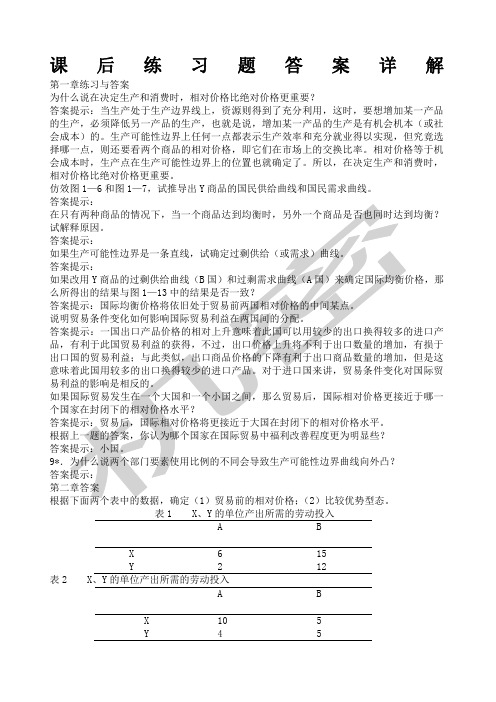
课后练习题答案详解第一章练习与答案为什么说在决定生产和消费时,相对价格比绝对价格更重要?答案提示:当生产处于生产边界线上,资源则得到了充分利用,这时,要想增加某一产品的生产,必须降低另一产品的生产,也就是说,增加某一产品的生产是有机会机本(或社会成本)的。
生产可能性边界上任何一点都表示生产效率和充分就业得以实现,但究竟选择哪一点,则还要看两个商品的相对价格,即它们在市场上的交换比率。
相对价格等于机会成本时,生产点在生产可能性边界上的位置也就确定了。
所以,在决定生产和消费时,相对价格比绝对价格更重要。
仿效图1—6和图1—7,试推导出Y 商品的国民供给曲线和国民需求曲线。
9* 表1 X 、Y 的单位产出所需的劳动投入A B X Y 6215 12 表2 X 、Y 的单位产出所需的劳动投入A BX Y 10 45 5答案提示:首先将劳动投入转化为劳动生产率,然后应用与本章正文中一样的方法进行比较。
(表2-2(a )和表2-2(b )部分的内容)假设A 、B 两国的生产技术条件如下所示,那么两国还有进行贸易的动机吗?解释原因。
表3 X 、Y 的单位产出所需的劳动投入A B X Y 4 2 8 4答案提示:从绝对优势来看,两国当中A 国在两种产品中都有绝对优势;从比较优势来看,两国不存在相对技术差异。
所以,两国没有进行国际贸易的动机。
证明如果一国在某一商品上具有绝对优势,那么也必具有比较优势。
——题出错了A Y X b b /〉,5个X 答案提示:封闭条件下,此国生产可能性边界的斜率是5。
因为X 的国际相对价格为2,所以此国出口X 进口Y 。
出口1,000个单位的X 可以换得2,000个单位的Y 。
贸易三角是CADA ’(见图2-5(a ))。
在图2—2(b )中,过剩供给曲线两端是否有界限?试解释原因。
答案提示:过剩供给曲线两端是有界限的,因为一国生产能力和消费需求是有界限的。
8*. 仿照图2—4,你能否画出这样一种情形:两条曲线的交点所决定的国际均衡价格与某一国封闭下的相对价格完全相同?如何解释这种结果?答案提示:从大国、小国的角度考虑。
萨尔瓦多《国际经济学》课后习题详解(国际贸易的标准理论)【圣才出品】
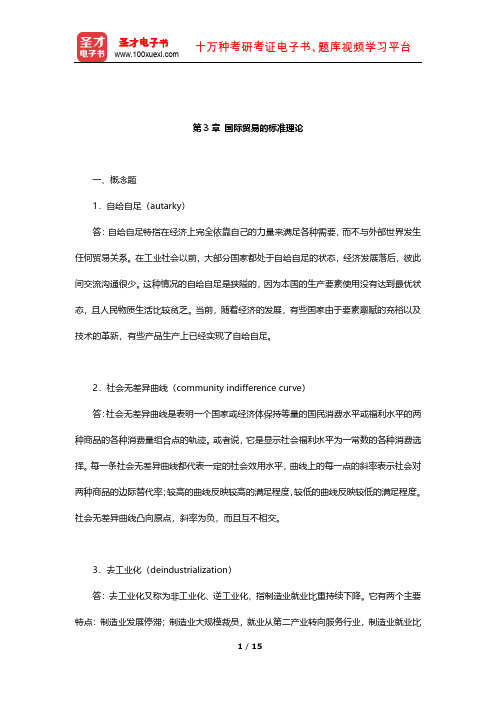
第3章国际贸易的标准理论一、概念题1.自给自足(autarky)答:自给自足特指在经济上完全依靠自己的力量来满足各种需要,而不与外部世界发生任何贸易关系。
在工业社会以前,大部分国家都处于自给自足的状态,经济发展落后,彼此间交流沟通很少。
这种情况的自给自足是狭隘的,因为本国的生产要素使用没有达到最优状态,且人民物质生活比较贫乏。
当前,随着经济的发展,有些国家由于要素禀赋的充裕以及技术的革新,有些产品生产上已经实现了自给自足。
2.社会无差异曲线(community indifference curve)答:社会无差异曲线是表明一个国家或经济体保持等量的国民消费水平或福利水平的两种商品的各种消费量组合点的轨迹。
或者说,它是显示社会福利水平为一常数的各种消费选择。
每一条社会无差异曲线都代表一定的社会效用水平,曲线上的每一点的斜率表示社会对两种商品的边际替代率;较高的曲线反映较高的满足程度,较低的曲线反映较低的满足程度。
社会无差异曲线凸向原点,斜率为负,而且互不相交。
3.去工业化(deindustrialization)答:去工业化又称为非工业化、逆工业化,指制造业就业比重持续下降。
它有两个主要特点:制造业发展停滞;制造业大规模裁员,就业从第二产业转向服务行业,制造业就业比重急剧下降。
去工业化现象最早始于美国。
一般来说,去工业化现象是出现在一些大城市地区以及那些以资源为基础、传统的衰退产业相对集中的老工业基地。
这主要是因为:①大城市地区土地租金和工资等生产成本较高,劳动和环境保护意识较强,加上市中心区生活和环境质量的下降,导致企业家把制造工厂由发达国家大城市迁移到中小城镇和农村地区,甚至迁移到国外。
②由于资源的枯竭和生产成本的上升,工业发达国家的一些传统产业如钢铁、造船、工程机械和纺织等,逐步走向衰退。
这些衰退产业主要集中在一些老工业基地,由此导致这些地区制造业出现严重的下降。
③随着技术发展,企业可以把生产过程的某些部分,尤其是劳动密集型的加工装配环节,分散到国外工资成本相对低廉的地区,而发展中国家提供的各种优惠政策又加剧了这种趋势。
(完整版)国际经济学第十版课后答案(萨尔瓦多、杨冰译)
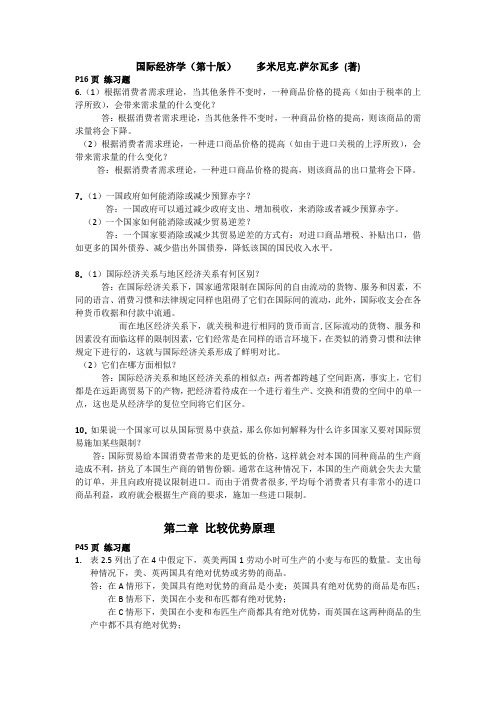
国际经济学(第十版)多米尼克.萨尔瓦多(著)P16页练习题6.(1)根据消费者需求理论,当其他条件不变时,一种商品价格的提高(如由于税率的上浮所致),会带来需求量的什么变化?答:根据消费者需求理论,当其他条件不变时,一种商品价格的提高,则该商品的需求量将会下降。
(2)根据消费者需求理论,一种进口商品价格的提高(如由于进口关税的上浮所致),会带来需求量的什么变化?答:根据消费者需求理论,一种进口商品价格的提高,则该商品的出口量将会下降。
7.(1)一国政府如何能消除或减少预算赤字?答:一国政府可以通过减少政府支出、增加税收,来消除或者减少预算赤字。
(2)一个国家如何能消除或减少贸易逆差?答:一个国家要消除或减少其贸易逆差的方式有:对进口商品增税、补贴出口,借如更多的国外债券、减少借出外国债券,降低该国的国民收入水平。
8.(1)国际经济关系与地区经济关系有何区别?答:在国际经济关系下,国家通常限制在国际间的自由流动的货物、服务和因素,不同的语言、消费习惯和法律规定同样也阻碍了它们在国际间的流动,此外,国际收支会在各种货币收据和付款中流通。
而在地区经济关系下,就关税和进行相同的货币而言,区际流动的货物、服务和因素没有面临这样的限制因素,它们经常是在同样的语言环境下,在类似的消费习惯和法律规定下进行的,这就与国际经济关系形成了鲜明对比。
(2)它们在哪方面相似?答:国际经济关系和地区经济关系的相似点:两者都跨越了空间距离,事实上,它们都是在远距离贸易下的产物,把经济看待成在一个进行着生产、交换和消费的空间中的单一点,这也是从经济学的复位空间将它们区分。
10.如果说一个国家可以从国际贸易中获益,那么你如何解释为什么许多国家又要对国际贸易施加某些限制?答:国际贸易给本国消费者带来的是更低的价格,这样就会对本国的同种商品的生产商造成不利,挤兑了本国生产商的销售份额。
通常在这种情况下,本国的生产商就会失去大量的订单,并且向政府提议限制进口。
萨尔瓦多《国际经济学》课后习题详解(外汇市场与汇率)【圣才出品】
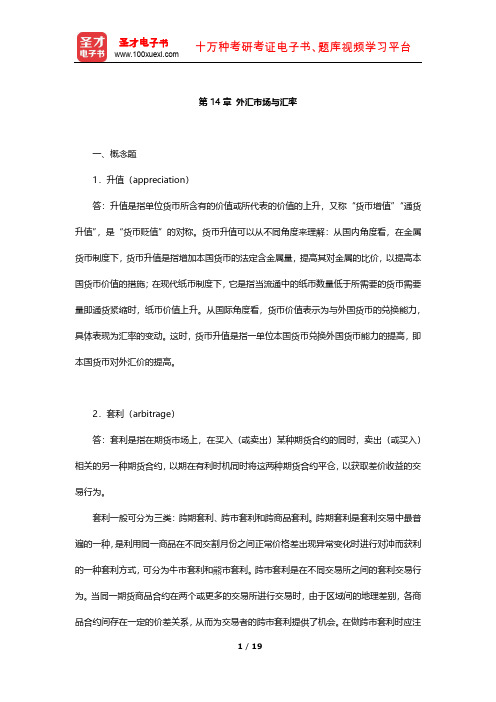
第14章外汇市场与汇率一、概念题1.升值(appreciation)答:升值是指单位货币所含有的价值或所代表的价值的上升,又称“货币增值”“通货升值”,是“货币贬值”的对称。
货币升值可以从不同角度来理解:从国内角度看,在金属货币制度下,货币升值是指增加本国货币的法定含金属量,提高其对金属的比价,以提高本国货币价值的措施;在现代纸币制度下,它是指当流通中的纸币数量低于所需要的货币需要量即通货紧缩时,纸币价值上升。
从国际角度看,货币价值表示为与外国货币的兑换能力,具体表现为汇率的变动。
这时,货币升值是指一单位本国货币兑换外国货币能力的提高,即本国货币对外汇价的提高。
2.套利(arbitrage)答:套利是指在期货市场上,在买入(或卖出)某种期货合约的同时,卖出(或买入)相关的另一种期货合约,以期在有利时机同时将这两种期货合约平仓,以获取差价收益的交易行为。
套利一般可分为三类:跨期套利、跨市套利和跨商品套利。
跨期套利是套利交易中最普遍的一种,是利用同一商品在不同交割月份之间正常价格差出现异常变化时进行对冲而获利的一种套利方式,可分为牛市套利和熊市套利。
跨市套利是在不同交易所之间的套利交易行为。
当同一期货商品合约在两个或更多的交易所进行交易时,由于区域间的地理差别,各商品合约间存在一定的价差关系,从而为交易者的跨市套利提供了机会。
在做跨市套利时应注意影响各市场价格差的几个因素,如运费、关税、汇率等。
跨商品套利指的是利用两种不同、但相关联商品之间的价差进行交易。
这两种商品之间具有相互替代性或受同一供求因素制约。
跨商品套利的交易形式是同时买进和卖出相同交割月份但不同种类的商品期货合约。
3.抛补套利(covered interest arbitrage)答:抛补套利是指套利者在把资金从甲地调往乙地以获取较高利息的同时,还在外汇市场上卖出远期的乙国货币以防止风险。
它是一种套利与掉期相结合的一种交易,通过这种交易既可以获得利率差额的好处,同时又可以获得较高的利息收入,但是要付出一笔掉期成本。
ch04国际经济学课后答案与习题萨尔瓦多
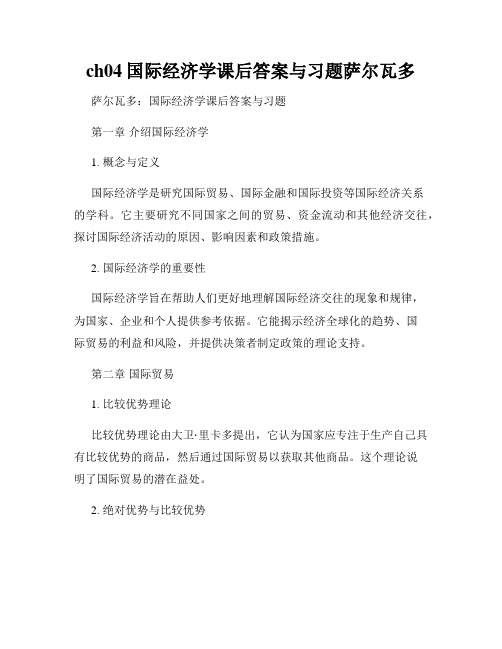
ch04国际经济学课后答案与习题萨尔瓦多萨尔瓦多:国际经济学课后答案与习题第一章介绍国际经济学1. 概念与定义国际经济学是研究国际贸易、国际金融和国际投资等国际经济关系的学科。
它主要研究不同国家之间的贸易、资金流动和其他经济交往,探讨国际经济活动的原因、影响因素和政策措施。
2. 国际经济学的重要性国际经济学旨在帮助人们更好地理解国际经济交往的现象和规律,为国家、企业和个人提供参考依据。
它能揭示经济全球化的趋势、国际贸易的利益和风险,并提供决策者制定政策的理论支持。
第二章国际贸易1. 比较优势理论比较优势理论由大卫·里卡多提出,它认为国家应专注于生产自己具有比较优势的商品,然后通过国际贸易以获取其他商品。
这个理论说明了国际贸易的潜在益处。
2. 绝对优势与比较优势绝对优势是指某个国家在生产某种商品上的效率高于其他国家,而比较优势则是指某个国家在生产某种商品上的机会成本低于其他国家。
比较优势是基于机会成本而产生的。
第三章国际金融1. 汇率与汇率制度汇率是一种货币兑换为另一种货币的比率。
汇率制度是指国家对其货币与其他货币之间的兑换比率进行管理和调整的体系。
汇率制度根据不同的货币政策和国家经济状况而有所不同,如固定汇率制和浮动汇率制等。
2. 随机汇率与管理型汇率制度随机汇率是由市场力量决定的汇率,在市场上自由浮动。
管理型汇率制度是由政府或央行干预市场来控制或影响汇率的变动。
第四章国际投资1. 直接投资与证券投资直接投资是指投资者通过购买或建立企业、工厂或设施等方式,在境外进行经济活动。
证券投资则是指投资者通过购买股票、债券或其他金融资产来获得收益。
2. 外国企业与政府投资外国企业可以通过直接投资的方式,在其他国家建立子公司或扩大在其它国家的经营规模。
政府投资则是指政府通过直接投资的方式,参与国际投资活动,以增加国家的影响力和经济实力。
结语国际经济学是一门重要的学科,它帮助我们理解国际经济交往的规律,为决策者制定政策提供理论支持。
